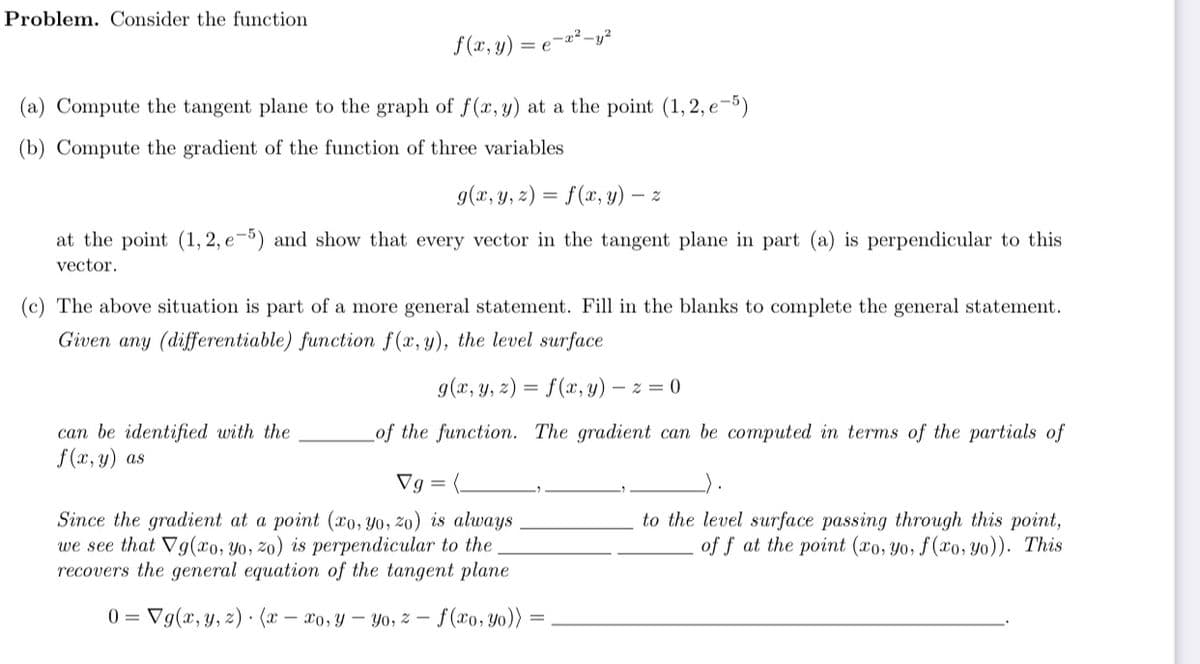Problem. Consider the function f(x, y) = e-²-y? (a) Compute the tangent plane to the graph of f(x, y) at a the point (1, 2, e-5) (b) Compute the gradient of the function of three variables g(x, y, z) = f(x, y) – z at the point (1, 2, e-5) and show that every vector in the tangent plane in part (a) is perpendicular to this vector. (c) The above situation is part of a more general statement. Fill in the blanks to complete the geeral statement. Given any (differentiable) function f(x, y), the level surface g(x, y, z) = f(x, y) – - z = 0 can be identified with the f(r, y) as of the function. The gradient can be computed in terms of the partials of Vg = Since the gradient at a point (xo, yo, 2o) is always we see that Vg(xo, yo, zo) is perpendicular to the recovers the general equation of the tangent plane to the level surface passing through this point, of f at the point (ro, yo, f(ro, yo)). This 0 = Vg(x, y, z)· (x – xo, y - Yo, z - f(xo, yo))
Problem. Consider the function f(x, y) = e-²-y? (a) Compute the tangent plane to the graph of f(x, y) at a the point (1, 2, e-5) (b) Compute the gradient of the function of three variables g(x, y, z) = f(x, y) – z at the point (1, 2, e-5) and show that every vector in the tangent plane in part (a) is perpendicular to this vector. (c) The above situation is part of a more general statement. Fill in the blanks to complete the geeral statement. Given any (differentiable) function f(x, y), the level surface g(x, y, z) = f(x, y) – - z = 0 can be identified with the f(r, y) as of the function. The gradient can be computed in terms of the partials of Vg = Since the gradient at a point (xo, yo, 2o) is always we see that Vg(xo, yo, zo) is perpendicular to the recovers the general equation of the tangent plane to the level surface passing through this point, of f at the point (ro, yo, f(ro, yo)). This 0 = Vg(x, y, z)· (x – xo, y - Yo, z - f(xo, yo))
Algebra & Trigonometry with Analytic Geometry
13th Edition
ISBN:9781133382119
Author:Swokowski
Publisher:Swokowski
Chapter8: Applications Of Trigonometry
Section8.3: Vectors
Problem 60E
Related questions
Question

Transcribed Image Text:Problem. Consider the function
f (x, y)
-x²-y?
= e
(a) Compute the tangent plane to the graph of f(x, y) at a the point (1, 2, e-5)
(b) Compute the gradient of the function of three variables
g(x, y, 2) = f(x, y) –
at the point (1, 2, e-5) and show that every vector in the tangent plane in part (a) is perpendicular to this
vector.
(c) The above situation is part of a more general statement. Fill in the blanks to complete the general statement.
Given any (differentiable) function f(x, y), the level surface
g(x, y, z) = f(x, y) – z = 0
can be identified with the
f (x, y) as
of the function. The gradient can be computed in terms of the partials of
Vg = (.
Since the gradient at a point (xo, Y0, 20) is always
we see that Vg(xo, Yo, 20) is perpendicular to the
recovers the general equation of the tangent plane
to the level surface passing through this point,
of f at the point (xo, Yo, f(xo, Yo)). This
0 = Vg(x, y, z) · (x – xo,y – Yo, z – f(xo, y0))
%3D
Expert Solution
This question has been solved!
Explore an expertly crafted, step-by-step solution for a thorough understanding of key concepts.
This is a popular solution!
Trending now
This is a popular solution!
Step by step
Solved in 3 steps

Knowledge Booster
Learn more about
Need a deep-dive on the concept behind this application? Look no further. Learn more about this topic, advanced-math and related others by exploring similar questions and additional content below.Recommended textbooks for you

Algebra & Trigonometry with Analytic Geometry
Algebra
ISBN:
9781133382119
Author:
Swokowski
Publisher:
Cengage

Algebra & Trigonometry with Analytic Geometry
Algebra
ISBN:
9781133382119
Author:
Swokowski
Publisher:
Cengage